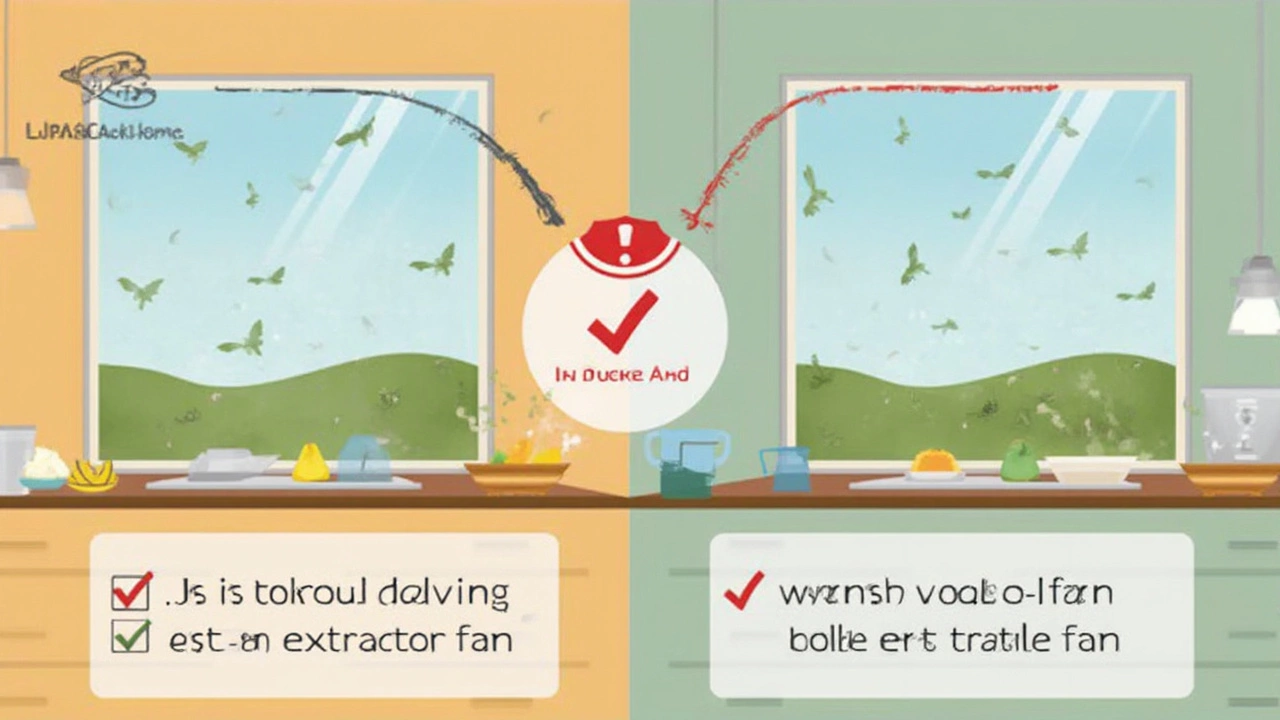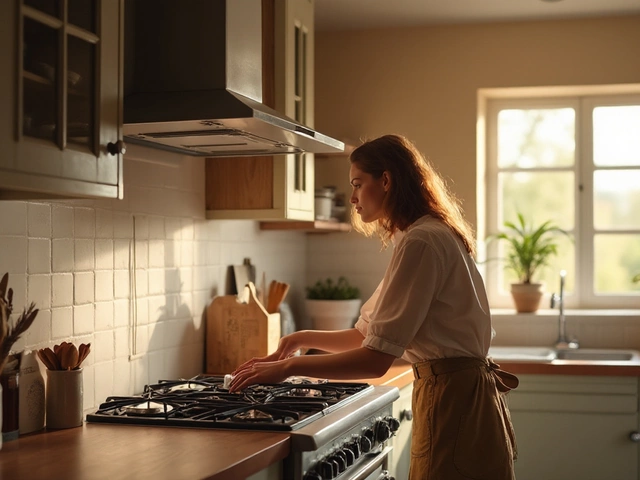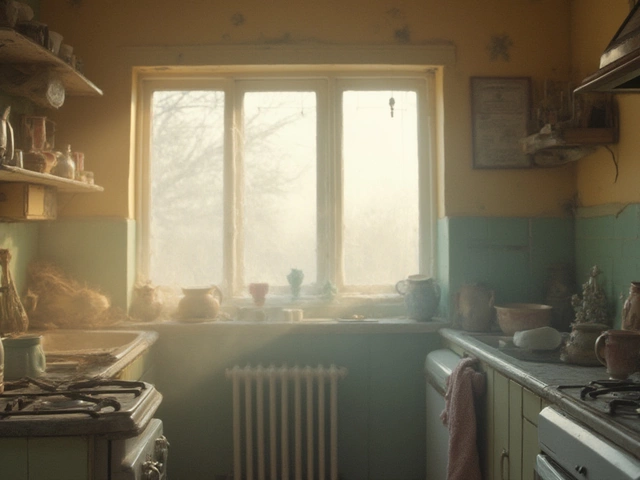If you’re planning a kitchen upgrade or just tackling repairs, the question pops up fast—do you actually need an extractor fan by law? It’s not just a throwaway detail; get this wrong and you might end up failing an inspection or dealing with mould and sticky walls.
Here’s the deal. In the UK, current building regulations say you need proper ventilation in kitchens, especially if you’re putting in a new kitchen or moving walls. Most of the time, this means an extractor fan. Why? Because cooking throws out a mix of steam, smells, and grease, and you don’t want that hanging around on your ceiling or in your lungs. If you’re renovating or building new, the rules are super clear—a window’s not always enough.
But things aren’t always so black and white, and that’s where it gets interesting. Some homes slip through with loopholes, like if your kitchen isn’t considered “new” or the changes are minor. Still, even when it’s not legally required, a fan makes a world of difference to your air quality and the lifespan of your kitchen. Stick around—we’ll break down the nitty gritty and help you figure out exactly what you need.
- The Law: What the Rules Say
- Exceptions and Grey Areas
- Why Proper Ventilation Matters
- Extractor Fan Repairs and Upgrades
- Expert Tips for a Healthier Kitchen
The Law: What the Rules Say
Here’s where things get real: if you live in England or Wales and plan to change your kitchen or do a major fix-up, the law says you need to think about kitchen ventilation. Building Regulations (specifically Part F) put this front and centre—cooking means steam, grease, and smells, and they can’t just build up. If you’re fitting out a brand new kitchen or moving sinks, units, or even walls, decent ventilation isn’t optional. You’re expected to deal with fumes and humidity so you don’t end up with damp, mould, or indoor air problems. That’s where the trusty extractor fan comes in.
So what do these regs actually say? If you’re putting in a new kitchen, your extractor fan needs to remove at least 30 litres of air per second if it’s mounted above the hob (think: your cooker hood). If it’s not directly above, then it needs to shift at least 60 litres per second—that’s a massive difference. And yes, these numbers aren’t pulled out of thin air: they're straight from Building Regs Part F, updated most recently in 2021.
| Ventilation Type | Minimum Extraction Rate (litres/sec) |
|---|---|
| Directly above hob | 30 |
| Elsewhere in kitchen | 60 |
There’s one more thing people get caught out on—recirculating cooker hoods do not meet these rules by themselves. You must have extraction to the outside, so fans that just filter and pump air back into your kitchen won’t pass a sign-off. This is a common snag with “open plan” flats or quick kitchen makeovers.
If you’re just replacing an old fan or cooker hood with the same kind, you’re usually fine. But big upgrades? The inspector might pay a visit. If you’re a landlord, strict rules mean rented flats and houses must have suitable extractor fan setups—otherwise damp, damage, and even angry tenants are coming your way.
The short version: don’t risk skimping on a kitchen extractor fan when sorting out ventilation. It’s not only about fresh air—it’s about meeting the law, avoiding fines, and keeping your kitchen safe.
Exceptions and Grey Areas
This is where people get tripped up. The rules for kitchen extractor fans in the UK aren't as simple as "every kitchen must have one." Building regs (specifically Document F) say you need "adequate means of ventilation." If you’re fitting a brand new kitchen, building an extension, or making major changes, then an extractor fan that vents to the outside is usually non-negotiable. But, if you’re just swapping out your old cabinets or changing a sink, the law doesn’t force you to add one.
What if you’ve got a window? If your kitchen is older and you’re not doing a full rip-out, sometimes a window for natural ventilation can tick the box. But, for new builds from 2006 onwards, a window alone isn’t enough—you need a mechanical extractor fan that meets a minimum rate (usually 30 litres per second above a hob or 60 litres per second for a whole-room fan).
Now, flats bring their own curveballs. If your flat has no external wall (which is common), ducting an extractor can be tricky. Sometimes, landlords and installers use recirculating fans with carbon filters. These are technically legal for replacement in existing spaces, but won't pass Building Control in new builds or full refurbs. Bet you didn’t know that if you’re renting and your landlord refuses to repair or fit a fan, it’s not automatically illegal—but if cooking fumes lead to damp or mould, it could become a housing issue.
- Extractor fan repair rules are way more relaxed than installation. If the fan was there before, and you just want to fix or swap it, you don’t need new permits.
- In listed buildings or conservation areas, you might need extra permission before cutting a vent hole—always check with your local council first.
- DIY installations get murky. If you’re running mains-powered fans, you might need an electrician to certify the work for safety.
Here's a quick look at when you legally need a kitchen ventilation system, and when you might get away without one:
| Scenario | Extractor Fan Required? |
|---|---|
| New build kitchen (post-2006) | Yes, always |
| Kitchen refit, just changing cabinets | Usually not required |
| Older kitchen, good window, no changes | Fan optional, but recommended |
| Flat with no outside wall | Brand new: must vent out, Recirculating fan for like-for-like swap |
The easiest way to avoid headaches? Check your local building control guidance before buying anything. And if you’re not sure, ask a pro—most kitchen fitters have this stuff memorised because failing to pass inspection is a giant pain.

Why Proper Ventilation Matters
No one loves sticky ceilings, lingering smells, or steamy windows. But there’s more at stake than just convenience—good kitchen ventilation does some important heavy lifting that most people don’t realise.
Cooking stirs up a mess of moisture, smoke, and grease. If this stuff hangs around, it settles on cupboards, paint, and even your lungs. Studies from Public Health England have pointed out that poor ventilation bumps up the risk of mould growth and indoor air pollution. That’s why extractor fans aren’t just “nice to have”—they help cut down those risks big time.
Without a kitchen extractor fan, you might notice:
- Mould popping up, especially in corners or behind cupboards.
- Wall and ceiling paint peeling or getting stained with grease.
- Persistent smells, making your kitchen feel stale or unpleasant.
- Foggy windows and even water running down the glass after you cook.
It doesn’t stop at surfaces. Modern studies have measured that indoor air in badly ventilated kitchens can sometimes contain up to four times higher pollutant levels than outside on a busy street. Kids, older folks, and anyone with asthma or allergies feel this the most.
If you rent your place, landlords have to make sure there’s suitable ventilation (that’s the damp and mould rules talking), so it’s not just about comfort—it’s about following the rules, too.
Want a tip? Use your extractor fan every time you cook. Even boiling a kettle dumps moisture in the air. Just remember to keep the blades and grill clean; dust and grease can choke airflow fast. This keeps your fan working hard and your kitchen safe for everyone.
| Problem | Without Extractor Fan | With Extractor Fan |
|---|---|---|
| Humidity After Cooking | High | Low |
| Visible Grease on Surfaces | Common | Rare |
| Mould Risk | Increased | Reduced |
| Lingering Odours | Yes | Minimal |
So, proper kitchen ventilation isn’t just ticking a box for building regs. It protects your health, keeps your home fresher, and means less scrubbing for you down the road.
Extractor Fan Repairs and Upgrades
Stuck with a noisy, clunky kitchen fan that can barely clear a frying pan’s worth of steam? You’re not alone. Most extractor fan issues boil down to old age, blocked filters, or just units that weren’t right for the space from the beginning. The good news: most repairs are simple, and you can often upgrade for way less than tearing out cabinets or repainting smoke stains.
First things first, know the basics. If your extractor fan isn’t pulling air like it used to, start with a deep clean. Grease and dust gunk up fans fast. Most manufacturers recommend cleaning metal filters every two months, but few people manage that. Swapping out carbon filters (if you’ve got a recirculating fan) once or twice a year also makes a noticeable difference.
If a clean doesn’t do the trick, check for obvious problems—broken buttons, burnt-out motors, or loose wiring. Safety tip: always cut the power before you take anything apart. Trying to fix electrical stuff while it’s live? Big mistake.
- Extractor fan repair costs can vary, but the usual spend for a basic fix in the UK lands between £40 and £150 for parts and labour.
- If your fan is older than 8-10 years or just doesn’t meet current kitchen ventilation standards, consider a replacement. New fans are much quieter and way more energy efficient.
Thinking of an upgrade? Here’s what you should look out for:
- Go for a unit with at least a 60L/s extraction rate if your hob isn't next to a window. That's the UK minimum for compliance with Building Regulations.
- Look for an A-rated energy label. Quieter fans (under 55 decibels) make a massive difference if you cook a lot or have an open plan kitchen.
- Boost functions and timer switches help keep air moving after you finish cooking, which is great for fighting off damp and odours.
Want some quick numbers? Here’s a comparison of the most common fan types and their maintenance costs:
| Fan Type | Average Repair Cost (£) | Average Lifespan |
|---|---|---|
| Wall-Mounted | 50-120 | 8-12 years |
| Ceiling / In-Line | 80-150 | 10-15 years |
| Recirculating | 40-100 | 6-10 years |
A properly working extractor fan keeps your kitchen healthy and your home in line with UK rules. If in doubt, get advice from a registered electrician. You’ll thank yourself next time you fry up bacon and your windows aren’t dripping with condensation.

Expert Tips for a Healthier Kitchen
If you want your kitchen to feel fresh, stay mould-free, and avoid surprise repair bills, a few smart moves go a long way. Here’s what really works, straight from people who fix and fit extractor fans every day.
- Go for the Right Size: Not all fans do the job equally. For most UK kitchens, you want an extractor that moves at least 60–90 cubic meters of air per hour per square meter of kitchen floor space. If your kitchen’s on the large side or you cook a lot with oil, consider something stronger.
- Clean the Filters Regularly: Grease builds up fast. Aim to wash metal filters every month and change charcoal filters every 3–6 months if you don’t have ducting to the outside. Skipping this is the main reason fans get noisy or smelly.
- Keep Air Flowing: A fan is only as good as the air coming in. Leave the kitchen door open when you cook, or open a window a crack during heavy frying. Fans struggle if there’s no fresh air to replace what they suck out.
- Choose the Right Extraction Route: Ducting to the outside always works better than recirculating models with charcoal filters. Not every kitchen allows for it, but external venting removes moisture and smells much more efficiently.
- Switch It On Early: Don’t wait until the kitchen’s steamy—the fan does its best work if you start it before you put food on the hob. Let it run for 10–15 minutes after you finish cooking.
Want a look at how poor ventilation stacks up? Here’s what happens when you don’t have decent extraction:
| Ventilation | Moisture & Mould Risk | Average Fan Service Life |
|---|---|---|
| Poor (No Fan/No Window) | High | 3-4 years |
| Moderate (Window Only) | Medium | 5-6 years |
| Good (Modern Extractor Fan) | Low | 8+ years |
If you’re not sure about your setup, ask a local extractor fan repair expert to check your fan and airflow. It could save you a lot of money (and headaches) later on.





